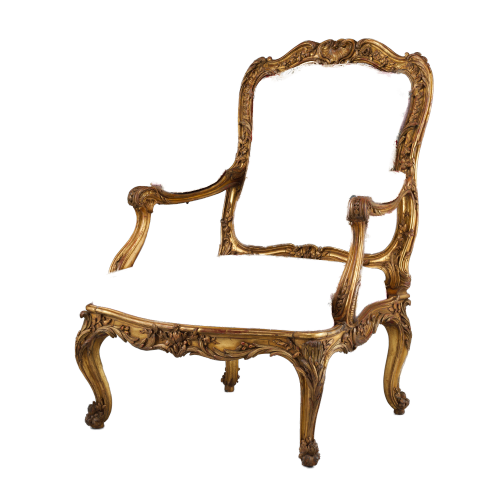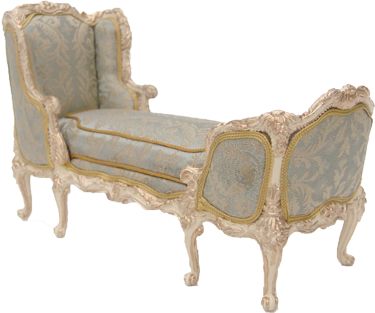
Armchair (fauteuil à la reine), frame by Nicolas-Quinibert Foliot. Carved and gilded beech. Photo: Metropolitan Museum of Art, New York (66.60.2). Photoshopped frame by Edra Stafaj, November 30, 2016, for A Virtual Enlightenment website.
The fauteuil à la reine armchair’s frame is shaped precisely in the Rococo style. Furniture of the Rococo period was marked by a graceful motion of shapes and forms. The entire frame of the chairs produced in this style appeared to flow into a continuous curving line. Furthermore, as Kisluk-Grosheide notes, “high-relief carving of twirling leaves, asymmetrical C- and S-shaped scrolls, flowers, and fanciful elements resembling rocks and shells” were all decorative elements employed to mask the areas where the cabriole legs and arm supports were joined.[1]
The fauteuil à la reine armchair is designed with low legs to allow for more comfort and a sense of stability in being grounded closely to the floor. In addition, the armrests are set back to accommodate the fashion of the hooped dress. The shape of chairs, however, continued to change in France, becoming more and more comfortable for the sitter. The a flat back of the fauteuil à la reine was soon replaced by a concave back and overstuffed cushion. From there, new models emerged, such as the marquise, a larger armchair for two people, and the duchesse, an extended lounge chair used for reclining, shown below.[2]
Chairs developed not just for comfort, but also for specific purposes. The desk chair, for instance, took on a semi-circular shape with an additional leg in front for support. There were also hair-dressing chairs that had an indented back for brushing a lady’s hair.[3]

Chaise longue or duchesse, 1760-1775. Original attributed to Jacques-Jean-Baptiste Tilliard.
To learn more about the woodwork process required to make the frame, see the menuiserie of chairmaking!
Return to: Making the Chair Next: Tapestry
[1] Kisluk-Grosheide, Daniëlle O. “French Furniture in the Eighteenth Century: Seat Furniture.” In Heilbrunn Timeline of Art History. New York: The Metropolitan Museum of Art, 2000–. http://www.metmuseum.org/toah/hd/sfurn/hd_sfurn.htm (October 2003)
[2] ibid.
[3] ibid.